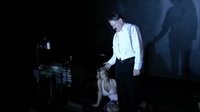Deconstructing the Past: A New Look at History
Deconstructing the Past: A New Look at History
Interview with Guy Cassiers
By Edwige Perrot
Translation: Jane Bemont
The most striking aspect of the book, for me anyway, and of the play that we made out of it, is the fact that the life of this character will only start making sense during World War II, when he is a doctor in Auschwitz. Just like in the rest of the book, that phase is also told in reverse: men and women rise up out of the ashes; the doctor gives them hair and gold teeth. And at that moment, his consciousness realizes that returning to the past has a purpose, that it gives meaning to things.
Theatre as a bastion against forgetting
Theatre as a bastion against forgetting
Searching for the mechanisms of violence
Searching for the mechanisms of violence
The darkness in each of us
The darkness in each of us
Language that defends the indefensible
Language that defends the indefensible
Theatre aimed at addressing individual responsibility
Theatre aimed at addressing individual responsibility
https://temoigner.revues.org/
De welwillenden (The Kindly Ones) opens on the 10th of March 2016 in Antwerp (Toneelhuis, BE).
Tour dates De welwillenden :
10.03.16 Toneelhuis, Bourla, Antwerpen (BE)
12 - 13.03.16 Toneelhuis, Bourla, Antwerpen (BE)
15 - 19.03.16 Toneelhuis, Bourla, Antwerpen (BE)
23 - 25.03.16 Le Phénix, Valenciennes (FR)
29 - 30.03.16 Kunstencentrum Vooruit, Gent (BE)
02.04.16 CC Hasselt (BE)
06 - 09.04.16 Stadsschouwburg Amsterdam (NL)
12 - 16.04.16 Stadsschouwburg Amsterdam (NL)
06 - 08.05.16 Istanbul Theatre Festival (TR)
18 - 21.05.16 Stadsschouwburg Amsterdam (NL)
24 - 28.05.16 Stadsschouwburg Amsterdam (NL)
02 - 04.06.16 Kaaitheater, Brussels (BE)
07.06.16 Stadsschouwburg Groningen (NL)
10 - 11.06.16 Stadsschouwburg Utrecht (NL)
14.06.16 Parkstad Limburg, Heerlen (NL)
16 - 17.06.16 Rotterdamse Schouwburg (NL)
22.06.16 Chassé Theater, Breda (NL)
05- 08.10.16 MC93, Paris (FR)
11 - 12.10.16 RomaEuropa, Rome (IT)
19 - 20.11.16 Festival Temporada Alta, Girona (ES)
23 - 24.01.17 Maison de la Culture d’Amiens (FR)
Production Toneelhuis, Toneelgroep Amsterdam
In collaboration with Le Phénix, Scène nationale de Valenciennes (FR), Maison de la Culture d’Amiens (FR), Istanbul Theatre Festival (TR), Festival Temporada Alta (ES), Festival RomaEuropa (IT)
Co-funded by the Creative Europe Programme of the European Union
Tour dates Sunken Red :
27.11.15 Parktheater Eindhoven (NL)
02 - 18.12.15 Théâtre de la Bastille, Parijs (FR)
06.01.16 Schouwburg Kortrijk (BE)
19.01.16 30CC, Leuven (BE)
02.02.16 CC Maasmechelen (BE)
14.06.16 Koninklijke Schouwburg Den Haag (NL)















































































 Deconstructing the Past: A New Look at History
Deconstructing the Past: A New Look at History




 Theatre as a bastion against forgetting
Theatre as a bastion against forgetting




 Searching for the mechanisms of violence
Searching for the mechanisms of violence







 The darkness in each of us
The darkness in each of us









 Language that defends the indefensible
Language that defends the indefensible





 Theatre aimed at addressing individual responsibility
Theatre aimed at addressing individual responsibility



